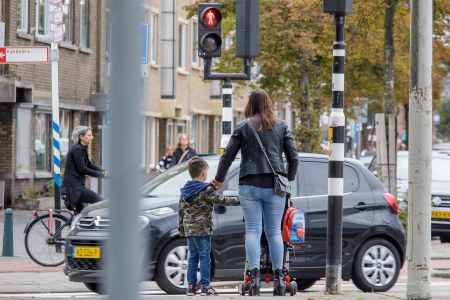The aim of traffic education is to achieve safe road user behaviour and the conditions required for it. These conditions concern knowledge, ability and willingness. The elaboration in educational goals should of course be tailored to the target group and their main road user role.
Defining educational goals is of great importance for defining educational activities and evaluating their effectiveness. There are general goals, main goals and learning goals (see [3]). General goals are very broadly defined to outline the domain of learning. The general goal of traffic education is to achieve safe road user behaviour for the main road user roles of the target group and the necessary conditions in terms of knowledge, ability and willingness. Table 1 provides an example

Table 1. Examples of general goal/domain for formal traffic education by target group. Source: [3].
Main goals subsequently describe what an education activity is meant to achieve, for example, that a child is able to cross the road safely, that a driver recognises the risk of speeding, or that someone has mastered manoeuvring a mobility scooter. Finally, learning goals are very concrete elaborations of the main goals: what does safe crossing look like, what exactly must someone who recognises the risk of speeding do or say, what manoeuvres with a mobility scooter must be mastered in what circumstances. Learning goals should always be ‘SMART’ [3]:
- Specific (addressing a concrete subject);
- Measurable (verifiable whether the goal was met);
- Acceptable (sufficiently motivating to want to learn about the particular subject);
- Realistic (feasible); and
- Time-bound (with a deadline).
Following the GDE matrix (Goals of Driver Education), the goals of traffic education can be organised accordingly, making a distinction by level of traffic participation and aspects of the traffic task [4] [5]. The four levels of traffic participation, the rows of the GDE matrix, are:
- General level: personal motives and tendencies (e.g., degree of impulsivity, risk acceptance).
- Strategic level: considerations and decisions prior to travel (e.g., what route to take, what time to leave).
- Tactical level: interaction in traffic (e.g. whether to give right of way, whether to indicate direction).
- Operational level: vehicle control/operation (for example, shifting gears in a car and getting on and off a bicycle).
The three aspects of the traffic task, the columns of the GDE matrix, are:
- Knowledge and skills: what you need to know and be able to do in order to participate in traffic safely.
- Risk-increasing factors: the factors that increase crash risk, why this is so and how to avoid such risks.
- Self-assessment: the extent to which you are able to participate in traffic safely and how to adjust your behavioural choices accordingly (calibration).
